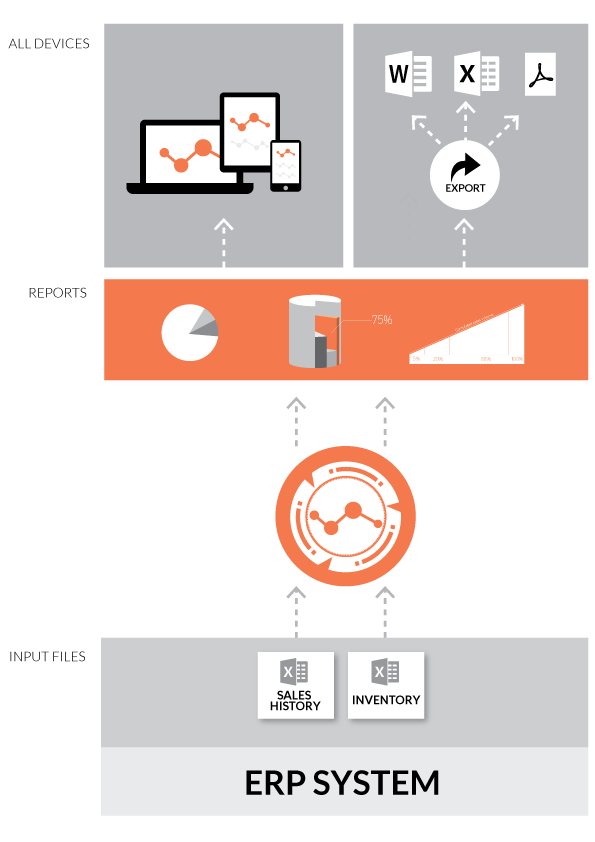Today’s market conditions and the complex economic relationships in the world impose the need for companies to manage supplies and equipment inventory more effectively. Inventory optimization is in fact recognized as a critical factor for success by all forward-thinking companies. Avoiding a situation where the capital is tied up in inventory and at the same time having enough inventory on hand to meet customer’s demands represent two imperatives in extremely competitive business climate.
Maximizing the efficiency of scarce capital while making timely deliveries sounds like a combination each company would embrace. In order to accomplish this operations personnel and their management have to be able to successfully manage this constantly shifting balance point.
Inventory is probably one of the most important assets of many distribution companies. Sometimes much more capital is tied up in inventory than in equipment and properties. The Pareto principle states that 80% of the overall consumption value is based on only 20% of total items. Evidently, demand is not evenly distributed between items: best sellers vastly outperform the rest.
It’s difficult to turn inventory back into money in order to cover salaries and other expenses. This clearly indicates that investing in right products is essential for both manufactures and distributors. IAM solution allows them to closely monitor the performance of their investment in inventory. With IAM professionals will be able to enjoy full visibility into all relevant inventory trends and perform optimization of inventory levels and purchasing process.
01. Features
System configuration
IAM is fully flexible when it comes to configuration. Namely IAM can be configured for the system of warehouses and supply chains that are hierarchical and organized per territories (Area, Region, and Country). In other words, user has the ability to map the hierarchy of warehouses into the IAM and perform calculations and analysis per previously defined segments of hierarchy.
Data filtering
Selection of data that is used for calculating analysis and trends can be filtered before and after the calculation(s).
Reporting system
- Inventory Profile (shows inventory value per stocking category, share of each stocking category in coverage and stock rotation)
- ABC analysis (lists all items reported in the sales history and in the stock file, defines a stocking policy for each item)
- Inventory Balance (highlights the problems areas in terms of low or high stocks)
- Low stock situation (the items to be re-ordered for the market needs)
- High stock situation (items that are too long on the stock)
- Calculated availability (provides a detailed availability per stocking category and the total availability of items over time and projects potential availability that could be achieved using an advanced replenishment system)
- Customer base mapping (the presence of certain customers in the sales volume)
- Availability per customer (this report gives an idea of the delivery service performance you have to the major customers)
- Split of sales lines between suppliers (this report shows the split of the total sales between suppliers)
- Split of stock between suppliers (this section shows the split of the total stock value between suppliers)
Analysis of comparative calculations
Comparison report – ABC analysis
Comparison reports – Inventory Balance
Comparison reports – Low and high stock development
Comparison reports – Availability
Summary report
Full report – All available reports as one cumulative
02. Requirements
Files needed for import
Your Sales history file for last 12 months
Your Inventory file
Format
CSV, XLS or XLSX format needed by IAM in order to generate your inventory analysis
All prices must be in the same currency in both files
Sales history file
Sales history file should list each single invoice line and contain:
- Designation, Quantity and Price (mandatory)
- Supplier, Package code, Unit of measure, Critical flag, Minimum stock level and Maximum stock level (optional)
Inventory file
Inventory file should contain:
- Designation, Quantity and Price (mandatory)
- Supplier, Package code, Unit of measure, Critical flag, Minimum stock level and Maximum stock level (optional)

03. Benefits
- Run your inventory efficiently
- Identify overstocked/understocked items
- Reduce inventory value for 15 – 35%
- Optimize your investment in inventory
- Estimating your delivery performance
- Quickly determine which items / item groups are your top sellers
- Getting an overview how well your stock is balanced between fast and slow moving or high and low volume items
- Increase the service level and monitor service level by customer
- Determine maximum and minimum stock levels
- Independently check your ERP inventory planning performance